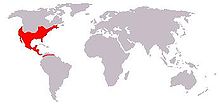
Back Urocyon cinereoargenteus AN ثعلب رمادي Arabic ثعلب رمادى ARZ Bresituzol (Urocyon cinereoargenteus) AVK اوروسیون کینروارقنتوس AZB Шэрая лісіца Byelorussian Шэрая лісіца BE-X-OLD Сива лисица Bulgarian Louarn gris Breton Guineu grisa Catalan
| Gray fox | |
|---|---|

| |
| in Tulum, Mexico | |
| Scientific classification | |
| Domain: | Eukaryota |
| Kingdom: | Animalia |
| Phylum: | Chordata |
| Class: | Mammalia |
| Order: | Carnivora |
| Family: | Canidae |
| Genus: | Urocyon |
| Species: | U. cinereoargenteus
|
| Binomial name | |
| Urocyon cinereoargenteus (Schreber, 1775)
| |

| |
| Gray fox range | |
The gray fox (Urocyon cinereoargenteus), or grey fox, is an omnivorous mammal of the family Canidae, widespread throughout North America and Central America. This species and its only congener, the diminutive island fox (Urocyon littoralis) of the California Channel Islands, are the only living members of the genus Urocyon, which is considered to be genetically sister to all other living canids. Its species name cinereoargenteus means "ashen silver".
It was once the most common fox in the eastern United States, and though still found there, human advancement and deforestation allowed the red fox to become the predominant fox-like canid. Despite this post-colonial competition, the gray fox has been able to thrive in urban and suburban environments, one of the best examples being southern Florida.[2][3] The Pacific States and Great Lakes region still have the gray fox as their prevalent fox.[4][5][6]
- ^ Roemer, G.; Cypher, B.; List, R. (2016). "Urocyon cinereoargenteus". IUCN Red List of Threatened Species. 2016: e.T22780A46178068. doi:10.2305/IUCN.UK.2016-1.RLTS.T22780A46178068.en. Retrieved 12 November 2021.
- ^ Fleshler, David (25 November 2015). "Gray foxes thrive in South Florida – but are rarely seen". Sun-Sentinel. South Florida. Retrieved 2 January 2022.
- ^ "Wild foxes dwell among us". Sun-Sentinel. South Florida. 23 September 2005. Retrieved 2 January 2022.
- ^ Merrill, Andrea (25 February 2021). "Foxes of the Pacific Northwest". Animals of the Pacific Northwest. Retrieved 2 January 2022.
- ^ "Gray Fox". Irvine Ranch Conservancy. Wildlife spotlight. Retrieved 2 January 2022.[permanent dead link]
- ^ "Gray Fox (Urocyon cinereoargenteus)". mnmammals.d.umn.edu. Minnesota mammals. Duluth, MN: University of Minnesota. Retrieved 2 January 2022.
